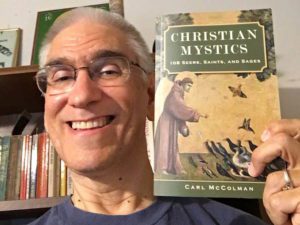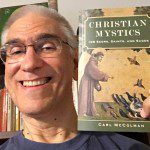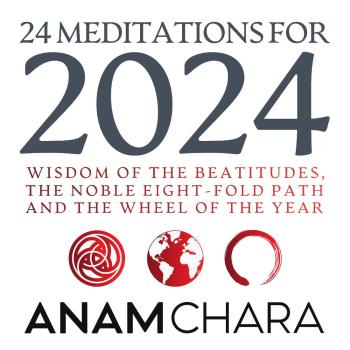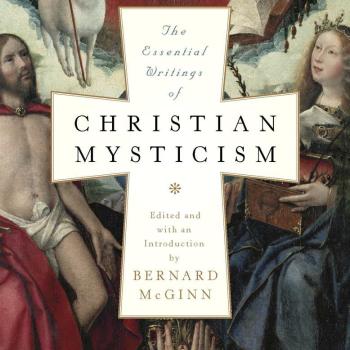 I’m happy to announce that my latest book — Christian Mystics: 108 Seers, Saints and Sages — has been published. The first printing has been delivered to my publisher’s warehouse, and they are now in the process of being shipped out to bookstores (both online and brick & mortar). So your favorite bookseller should have stock any day now.
I’m happy to announce that my latest book — Christian Mystics: 108 Seers, Saints and Sages — has been published. The first printing has been delivered to my publisher’s warehouse, and they are now in the process of being shipped out to bookstores (both online and brick & mortar). So your favorite bookseller should have stock any day now.
I got my first copies yesterday, and even though this is hardly my first book, it’s as exciting as if it were. Kudos to the folks at Hampton Roads Publishing Company for designing the book so beautifully.
If you’re connected to me on Facebook or Twitter, you’ve probably already seen this picture, but here it is for the rest of you: I call it “the obligatory author-with-brand-new-book selfie.” I think I look like a goofball, but I’m excited, so you get to see me in all my goofy glory.
Prefer reading your books on the Kindle? Order the Kindle version by clicking here (will be delivered to your Kindle on October 1).
I am honored (and, frankly, humbled) by the warm praise that this book has received from authors whom I admire. Richard Rohr says “How blessed we are to have this book!” while Mirabai Starr calls it “an elegant guide to the essence of those awakened souls.” Rabbi Rami Shapiro says this book “invites us to dive deep and discover a Christianity most of us have never even imagined.” Tilden Edwards calls it an “inspiring introduction” that will be “accessible to a wide range of people,” and Christine Valters Paintner calls it a “great gift of a distillation of 108 wise and worthy guides.” Like I said: I’m humbled.
 Christian Mystics is a book about, of course, the great mystics of the Christian tradition. If you’ve been reading my blog for a while, you know the kind of folks I keep talking about: Julian of Norwich, Meister Eckhart, Teresa of Ávila, John of the Cross, Evelyn Underhill, Thomas Merton, and so forth — as well as anonymous voices like the nameless authors of The Cloud of Unknowing or The Way of a Pilgrim. When we first bounced around the idea of doing this book, my editor and I talked about whether I should just limit myself to the 10 or 20 “well known” mystics, writing in-depth profiles of them, or whether I should also include a wide selection of lesser known figures, which would make for shorter profiles but a broader overview of the tradition. We decided to go for the latter, and now that the project is done, I’m glad we did.
Christian Mystics is a book about, of course, the great mystics of the Christian tradition. If you’ve been reading my blog for a while, you know the kind of folks I keep talking about: Julian of Norwich, Meister Eckhart, Teresa of Ávila, John of the Cross, Evelyn Underhill, Thomas Merton, and so forth — as well as anonymous voices like the nameless authors of The Cloud of Unknowing or The Way of a Pilgrim. When we first bounced around the idea of doing this book, my editor and I talked about whether I should just limit myself to the 10 or 20 “well known” mystics, writing in-depth profiles of them, or whether I should also include a wide selection of lesser known figures, which would make for shorter profiles but a broader overview of the tradition. We decided to go for the latter, and now that the project is done, I’m glad we did.
The hardest part of the job, ironically, was figuring out how to organize the book. Here’s how it looked to me: if you write a book about 100 mystics (give or take), the obvious ways to present them would be either alphabetically (from Abhishiktananda to William of St. Thierry) or chronologically (from John the Evangelist to Richard Rohr). But that would make this project either an encyclopedia or a history book, and neither of those formats really seemed helpful in terms of what I wanted the book to do: to introduce readers to the mystics as sources of wisdom, as spiritual guides we meet through the written word.
So as I mulled this over, I remembered one of my favorite quotes, from William McNamara: “The mystic is not a special kind of person; every person is a special kind of mystic.” Normally I think of that in terms of living people — how you and me and everyone else who seeks to respond to God’s love, needs to do so in the unique way that is best for each of us. But this principle applies to the great mystics of history as well: they are all different; each one is unique. So how to celebrate that diversity, and yet present the mystics in a user-friendly way?
And so I came up with the idea of devising nine broad categories — such as “visionaries,” “confessors,” “lovers,” “poets,” “saints” and so forth — and then profiling twelve representative mystics who embody the characteristics (and charisms) of each category.
It wasn’t a perfect solution: many of the greatest mystics, such as John of the Cross and Thomas Merton, could easily be placed in multiple categories! But I tried to put each figure in the category that seemed the best for him or her, and when the dust settled, I had 108 wonderful examples of how “every person is a special kind of mystic.”
Order your copy today — from Amazon, Barnes & Noble, or your favorite Independent Bookstore (Online or Near You)
So I hope that when you read this book, you won’t just be amassing a mountain of contemplative trivia (trust me, you won’t win any prizes if you do!) — but rather, that you will discover one or more new “spiritual teachers from the past” (well, actually three of the 108 are still alive) whose books or poetry will inspire you to become, well, the mystic you are meant to be. Because at the end of the day, reading the writings of the mystics only makes sense if we try to apply their wisdom and insight into our own lives. And not all of the mystics will speak to us — but the ones who do resonate with us, have the potential to lead us into profound interior transfiguration, all in response to the lavish love of God.
And that is something worth getting excited over!
Enjoy reading this blog?
Click here to become a patron.














